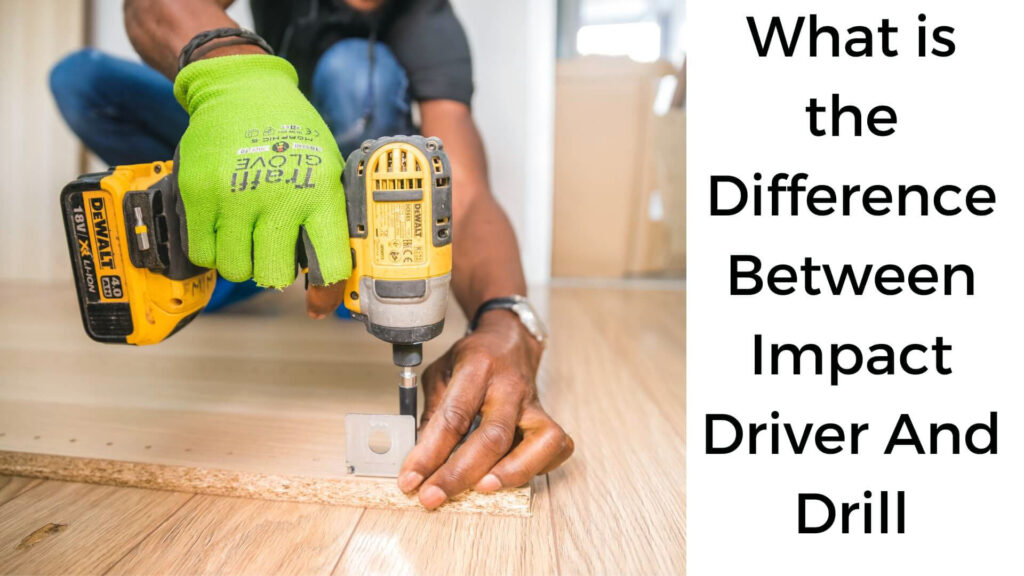When it comes to power tools, the drill has long been a household staple. However, the rise of the impact driver has created confusion for many DIYers and homeowners. These two tools may appear similar at first glance, but they have distinct differences that make them suitable for specific tasks. Understanding these differences will not only help you choose the right tool but also ensure that your home improvement and DIY projects are completed efficiently and with precision.
In this blog post, we’ll break down the key differences between an impact driver and a drill, focusing on factors such as power, torque, speed, size, and bit compatibility. Whether you’re building furniture, installing cabinets, or simply hanging picture frames, knowing which tool to use will make your projects easier and more enjoyable.
Table of Contents
Overview of Power Tools and their Importance in Home Improvement and DIY Projects
Power tools are essential in modern home improvement, construction, and DIY projects. They save time, increase accuracy, and reduce physical effort, allowing you to complete tasks more efficiently. Whether you’re driving screws, drilling holes, or fastening bolts, power tools like drills and impact drivers have become indispensable.
Why Are Power Tools So Important?
- Efficiency: Power tools significantly reduce the time required to complete tasks compared to manual tools.
- Precision: Tools like drills allow for precise hole-making, while impact drivers provide controlled screw driving.
- Versatility: From small repairs to major renovations, the right power tools can handle a wide variety of jobs.
- Reduced Fatigue: Instead of manual labor, power tools minimize strain on your body, making them great for repetitive tasks or heavy-duty work.
Two of the most commonly used power tools are the drill and the impact driver, and while they may seem interchangeable, each has its unique strengths. Understanding the distinctions between them is crucial for selecting the right tool for the job.
Brief Explanation of Impact Drivers and Drills
Let’s start with a basic introduction to both tools:
Drill
A drill, also known as a drill/driver, is one of the most versatile tools you can own. It’s primarily used for drilling holes in various materials such as wood, metal, and plastic, but it can also drive screws. Most modern drills are cordless, offering flexibility and ease of use.
- Common Use: Drilling holes, driving screws, and light DIY tasks.
- Operation: The drill rotates a bit to create holes or drive screws. You control the speed and torque through adjustable settings.
- Flexibility: Can handle a wide variety of tasks, including attaching flat-pack furniture, hanging shelves, and making pilot holes.
Impact Driver
An impact driver is designed for one primary purpose: driving screws and fasteners with power and efficiency. Unlike a standard drill, it delivers more torque by using both rotational force and concussive blows (impacts) to drive screws deep into tough materials like wood or metal.
Efficiency: Great for heavy-duty projects that involve driving screws into hard materials without pre-drilling.
Common Use: Driving long screws, bolts, and fasteners into dense materials.
Operation: It applies a rapid, rotational hammering action, delivering high torque without requiring much physical effort from the user.
Read More: Decoding the Functionality of Impact Drivers
Importance of Understanding the Difference between the Two Tools
While both tools share some similarities, understanding the difference between an impact driver and a drill is essential for a few key reasons:
- Project Suitability: Using the wrong tool can result in poorly completed projects or even damage to materials. For example, a drill may struggle with driving long screws into hard surfaces, while an impact driver can drive them with ease.
- Tool Efficiency: Impact drivers are more efficient for heavy-duty fastening tasks, whereas a drill is better suited for precision hole drilling. Knowing when to use each tool will make your work faster and more efficient.
- Tool Longevity: Using the appropriate tool for specific tasks will reduce wear and tear on both the tool and its components.
With this foundation, let’s dive into the specific differences between these two power tools.
Read More: Best Impact Driver For Electricians in 2023
Differences between Impact Drivers and Drills
1. Power and Torque
Drill:
Drills offer adjustable torque and speed, which is sufficient for general household tasks. Most drills allow users to choose the torque level via a clutch, making them ideal for tasks that require precision, such as drilling holes or driving small screws.
- Torque Output: Drills usually offer less torque compared to impact drivers, which is why they struggle with heavy-duty tasks like driving large screws or bolts into tough materials.
- Best Use: Ideal for drilling holes, light to moderate screw driving, and precision work.
Impact Driver:
Impact drivers excel when high torque is required. They generate much more torque than standard drills because they combine rotational force with concussive blows, providing the power to drive long screws into dense materials without the user needing to apply much physical effort.
- Torque Output: Much higher than a standard drill, making impact drivers suitable for demanding jobs that require driving screws into hardwood, metal, or other dense materials.
- Best Use: Ideal for heavy-duty driving tasks, such as securing deck screws or assembling large structures.
2. Speed and Performance
Drill:
Drills typically come with variable speed settings, allowing you to control the speed based on the task. This versatility makes drills great for precision tasks, where slow and steady performance is necessary to avoid damaging delicate materials.
- Speed Control: Most drills offer variable speed options, with lower RPMs for tasks that require control (e.g., drilling into metal) and higher RPMs for softer materials (e.g., wood).
- Performance: A drill’s performance shines in precision tasks like drilling small pilot holes, driving small screws, or making controlled cuts.
Impact Driver:
Impact drivers are all about speed and power. While they don’t offer as much speed control as drills, they perform exceptionally well for driving fasteners quickly and efficiently. The impact action of the tool increases performance, especially when working with stubborn screws.
- Speed Control: Impact drivers typically have one or two-speed settings, focusing on delivering maximum power.
- Performance: Perfect for driving screws into tough materials, especially when speed and power are more important than precision.
3. Size and Weight
Drill:
Drills are typically larger and heavier than impact drivers, especially cordless models that use larger batteries. While drills offer versatility, their bulkier size can make them more cumbersome to use, especially in tight spaces or for extended periods.
- Weight: Can be heavier, particularly when using higher voltage batteries (18V or 20V).
- Size: Bulkier due to additional components like the adjustable clutch and larger chuck.
Impact Driver:
Impact drivers are generally more compact and lightweight compared to drills. Their smaller size makes them easier to handle, especially in confined spaces. Despite their smaller form factor, they deliver impressive power for driving screws.
- Weight: Lighter and more compact than most drills, making them easier to maneuver in tight spots.
- Size: Smaller and more ergonomic, ideal for overhead or awkward angle tasks.
4. Chuck Type and Bit Compatibility
Drill:
Drills typically use a keyless, three-jaw chuck that can hold a variety of round and hex-shaped bits. This makes drills incredibly versatile, as they can accommodate a wide range of drill bits, from small to large.
- Bit Compatibility: Can use round-shank, hex-shank, and various other types of drill bits and accessories.
- Chuck Type: Three-jaw chuck, which grips bits firmly for drilling or driving screws.
Impact Driver:
Impact drivers don’t use a traditional chuck. Instead, they have a hex collet that accepts hex-shanked driver bits. This limits the types of bits you can use but increases efficiency when switching between bits for driving tasks.
Chuck Type: Quick-release hex collet for easy bit changes.
Bit Compatibility: Only accepts 1/4-inch hex-shank bits, which are designed specifically for driving screws and bolts.
Read More: Can You Use An Impact Driver As An Impact Wrench?
Conclusion
In summary, the main differences between an impact driver and a drill lie in their power, torque, size, speed, and bit compatibility. While drills are versatile and essential for tasks that require precision, impact drivers excel in heavy-duty fastening jobs that demand high torque and quick work. Understanding these differences ensures that you’re using the right tool for the job, maximizing efficiency, and achieving the best results for your home improvement and DIY projects.
Which Tool Should You Choose?
- Use a Drill if: You need to drill holes or complete light to moderate screw-driving tasks that require precision.
- Use an Impact Driver if: You need to drive long screws or bolts into tough materials like hardwood, metal, or concrete.
Both tools serve important roles in any tool kit, and many DIYers and professionals alike find value in owning both. If you’re just starting out, a versatile drill may be the best first purchase. As you tackle heavier projects, an impact driver will become invaluable.
Read More: How to Use an Impact Drill?
Frequently Asked Questions
What Types of Drills Are Available for Home Use?
Common types include cordless drills, hammer drills, and drill presses. Each type serves specific functions, from general DIY projects to more specialized tasks like masonry work.
What Factors Should I Consider When Choosing a Drill or Impact Driver?
When choosing between a drill or an impact driver, consider factors like torque, speed, bit compatibility, and the type of project you’re working on. Drills are more versatile, while impact drivers excel in power and driving tasks.
What Size Drill Bit Should I Use for Common Projects?
For general-purpose home use, a 1/16 to 3/8-inch drill bit works well. For larger holes or masonry work, larger sizes are required.
How Do I Maintain My Drill for Longevity?
To maintain your drill, clean it after each use, lubricate moving parts, and store it in a dry, safe place. Regular battery charging is also key for cordless models.
What Safety Precautions Should I Take When Using a Drill or Impact Driver?
Always wear safety glasses, ensure the tool is switched off before changing bits, and avoid wearing loose clothing or jewelry that could get caught in the tool.
Final Remarks
Choosing between a drill and an impact driver ultimately depends on the types of projects you plan to tackle. While drills offer flexibility for a range of tasks, impact drivers provide the power needed for heavy-duty fastening. Understanding the differences between the two will ensure you make the right choice and complete your projects efficiently and safely.

Hey, I am MD Hrithik Hossain, I’m a huge fan of DIY crafts. My workshop is where I spend most of my spare time, and I’m always working on some project. To that end, I’d like to share some of my knowledge and experience with you in power tools, woodworking, and other specialized materials fabrication.
I will guide you with genuine knowledge that can assist you with deciding whether a drill is appropriate according to your requirements or not. If you want to find the best drill and know which type of drill is most suited for your needs, then I can guide you with my expertise. My passion lies in helping others find the correct products they need at an affordable price.


